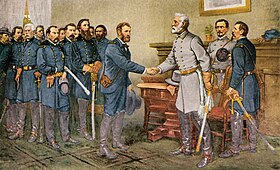
Back Bitva u Appomattoxu Czech Slaget ved Appomattox Courthouse Danish Gefecht bei Appomattox Court House German Batalla de Appomattox Spanish Appomattox Court Houseko gudua Basque نبرد اپوماتوکس کورت هاوس Persian Bataille d'Appomattox Court House French آپوماتوکس دادگاه GLK קרב אפומטוקס HE Bitka kod Appomattoxa Croatian
| Battle of Appomattox Court House | |||||||
|---|---|---|---|---|---|---|---|
| Part of the American Civil War | |||||||
 A print showing Ulysses S. Grant, Commanding General of the Union Army, accepting Confederate General in Chief Robert E. Lee's surrender on April 9, 1865 | |||||||
| |||||||
| Belligerents | |||||||
|
|
| ||||||
| Commanders and leaders | |||||||
|
Ulysses S. Grant George G. Meade Philip Sheridan Edward O.C. Ord |
Robert E. Lee Henry L. Benning John Gordon | ||||||
| Units involved | |||||||
|
Army of the Potomac Army of the Shenandoah Army of the James |
Army of Northern Virginia | ||||||
| Strength | |||||||
| 63,285[1] | 26,000[1] | ||||||
| Casualties and losses | |||||||
| 164 killed or wounded[2] |
195 killed[2] 305 wounded[2] 28,356 surrendered and paroled | ||||||
The Battle of Appomattox Court House, fought in Appomattox County, Virginia, on the morning of April 9, 1865, was one of the last, and ultimately one of the most consequential, battles of the American Civil War (1861–1865). It was the final engagement of Confederate General in Chief Robert E. Lee and his Army of Northern Virginia before they surrendered to the Union Army of the Potomac under the Commanding General of the United States Army, Ulysses S. Grant.
Lee, having abandoned the Confederate capital of Richmond, Virginia, after the nine-and-a-half-month Siege of Petersburg and Richmond, retreated west, hoping to join his army with Confederate forces, the Army of Tennessee in North Carolina. Union infantry and cavalry forces under General Philip Sheridan pursued and cut off the Confederates' retreat at the central Virginia village of Appomattox Court House. Lee launched a last-ditch attack to break through the Union forces to his front, assuming the Union force consisted entirely of lightly armed cavalry. When he realized that the cavalry was now backed up by two corps of federal infantry, he had no choice but to surrender with his further avenue of retreat and escape now cut off.
The signing of the surrender documents occurred in the parlor of the house owned by Wilmer McLean on the afternoon of April 9. On April 12, a formal ceremony of parade and the stacking of arms led by Confederate Maj. Gen. John B. Gordon to Union Brig. Gen. Joshua Chamberlain marked the disbandment of the Army of Northern Virginia with the parole of its nearly 28,000 remaining officers and men, free to return home without their major weapons but enabling men to take their horses and officers to retain their sidearms (swords and pistols), and effectively ending the war in Virginia.
This event signaled the end of the four-year-long war. It triggered a series of subsequent surrenders across the South, in North Carolina, Alabama and finally Shreveport, Louisiana, for the Trans-Mississippi Theater in the West by June.